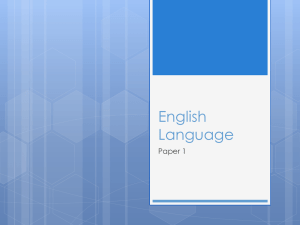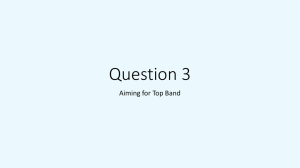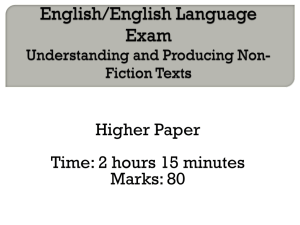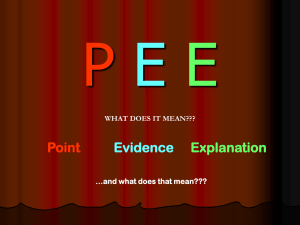Yr11 Parents` Information Evening 17/11/2014 Follow-up
advertisement
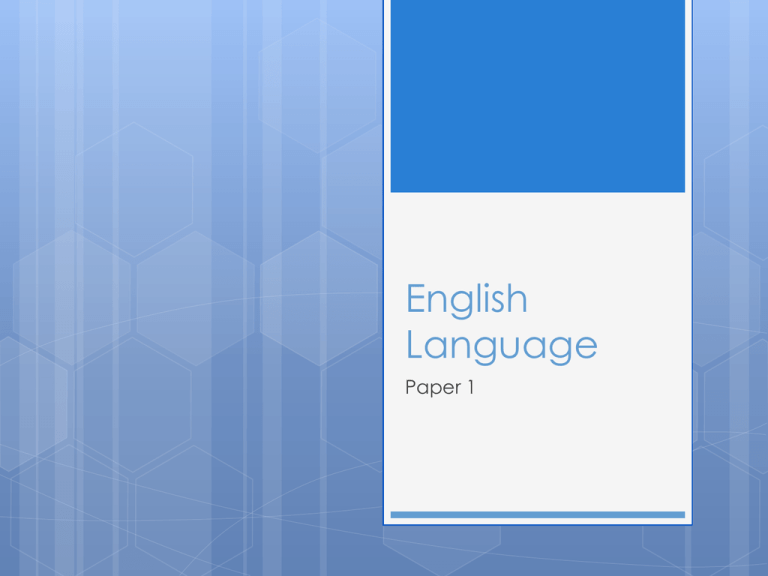
English Language Paper 1 What does the paper look like? 2 hours long; 1 hour for each section Section A: Reading Students read ONE non-fiction prose passage and answer 3-5 questions on it using PEE/PQA Section B Students answer ONE question from a choice of 3 Where can I get past papers from? Class teacher AQA website: http://www.aqa.org.uk/subjects/english/aqacertificate/english-language-8705/pastpapers-and-mark-schemes Central Resource Library at School (print off at school or take a USB stick into school): Start/Computer/Central Resource Library/English/000Past Papers for GCSE Reading Section A Top Tips for the Reading Section 1. 2. 3. 4. 5. Read the questions first Use a highlighter (these will be provided) to highlight key words Ensure you always link back to the question in your answer Practise reading articles and summarising them using quotes. There are extracts and questions in the booklet all pupils have received from their class teachers Practise past papers (available from AQA online or from class teachers) in order to ensure timing is accurate Mark Scheme for the Reading Section Use PEE/PQA Use short quotes Ensure you infer meaning from the quotes and develop your explanation or analysis of the quote Aim for between 2-4 paragraphs depending on the number of marks awarded for the question (normally between 4-10 marks) Foundation paper: sometimes it asks you to list for question 1 and this is fine without using PEE. Higher Paper Example Question and Answer Sample Question (Summer 2012) Text: Down and Out in Paris and London by George Orwell Question 4: What does this passage tell us about attitudes towards tramps in England in the early 1930s? Sample answer for the Reading Section (Q4) Sample answer for the Reading Section (Q4) Foundation Paper Sample Question and Answer Sample Question (Summer 2012) Text: Among the Thugs by Bill Buford Question 5: Refer to the whole passage (lines 1 – 37). What impression of football supporters does the writer give? Select evidence from the whole passage (lines 1 – 37) to support your ideas. Sample answer for the Reading Section (Q5) Sample answer for the Reading Section (Q5) Sample answer for the Reading Section (Q5) Writing Section B Tasks They are normally very similar for both HIGHER and FOUNDATION They are loosely linked to the extract that is used for Section A Sample Questions HIGHER (Summer 2012) Sample Questions Foundation (Summer 2012) Writing Options 1. 2. 3. Story Description Writing to argue/writing an argument Top Tips for the Writing Section Centres should be aware that candidates who offer very brief responses (3 paragraphs or less as a rough guide) are inevitably limiting their potential achievement. The Mark Scheme is divided into bands with each band containing four bullet points. The first of these is focused on content, the second on structure, the third on sentence structure and variation, and the fourth on technical accuracy. Centres should be aware that each of these four elements is given equal weight in the assessment of writing. It was noted that comma splicing was a frequent and detrimental feature of some candidates’ work, whilst the achievement of others was hampered by an inability to use commas accurately within sentences. Spend 5-10 minutes planning a good response – the examiners are looking for a ‘consciously crafted’ piece of work. Remember to ensure that you are writing for a specific audience and purpose Spend 5 minutes at the end checking your work You could create a plan that looks like this: Idea/part of the story Technique Technique Mark Scheme for the Writing Section It is divided EQUALLY into 4 sections: 1. Content 2. Structure 3. Sentence structure and variation 4. Technical accuracy (SPAG) Content: what are they looking for? 1. 2. 3. 4. Clear ideas and communication Conscious decisions made about writing to suit AUDIENCE and PURPOSE; evidence of crafting for a purpose and audience Selection of vocabulary for effect Use of discourse markers Structure – what are they looking for? 1. 2. 3. 4. 5. 6. 7. 8. 9. Paragraphs Repetition or a cohesive device Timeline More than one narrative strand Connectives (if applicable) 3rd person, 1st person Range of appropriate and sophisticated vocabulary Range of writing techniques used, e.g. similes Top End: use of a narrative structure and/or genre such as stream of consciousness, epistolary, Martian perspective, Todorov, tragedy, thriller, gothic and so on. What are they looking for Sentence Structure and Variation? Simple – short sentence normally with a subject, verb and object. Compound – 2 or more simple sentences using a connective such as: and, but, or, although etc. Complex – use of a subordinate clause Vary your use of these sentence types for impact. What are they looking for – Technical Accuracy? 1. 2. Spelling of common words MUST be correct. This includes homophones (their/they’re/there) as well as words that are commonly misspelt such as successful, necessary, beautiful, beginning and so on. See here: http://www.telegraph.co.uk/education/7930745/ Separate-is-most-commonly-misspelt-word.html Punctuation must be correct – misuse of commas was a common complaint by the exam board. Students should be using a range of punctuation accurately. Higher: Section B Example question and answer Sample Question “At about seven o’clock the cell doors were locked on the outside.” Write a story which starts or ends with this sentence. (25 marks) Sample answer for the Writing Section What do I do with this? Use it as an exemplary piece of writing and it’s only 3 ½ sides long. It achieved 25/25 despite 1 or 2 glaringly obvious mistakes You could use the mark scheme on slides 2226 and highlight evidence of how they achieve this mark, using a different highlighter colour for each strand of the mark scheme Foundation: Section B Example Question and Answer Sample Question Describe a frightening place. (25 marks) Sample answer for the Writing Section What do I do with this? Use it as an exemplary piece of writing and it’s only 2 ½ sides long. It achieved 25/25 despite 1 or 2 glaringly obvious mistakes You could use the mark scheme on slides 2226 and highlight evidence of how they achieve this mark, using a different highlighter colour for each strand of the mark scheme Useful Hints and Tips Revision Ideas If you only have 10-15 minutes… 1. 2. 3. 4. 5. 6. Print out a past paper Read the questions for Section A Read the extract, making brief notes in margin as you go to ensure you understand what you’re reading Re-read/skim read the extract, highlighting quotes in response to the questions Try to do this in 15 minutes – be strict with yourself and use a timer. When you have more time, write the answers up using PEE/PQA Use the detail in the extract to explore the writer. Are they witty? Do you get a sense of their attitude? What have we learnt about them? How would you identify their style? What’s their purpose? What tone does the writer convey? Are they likeable? Can you relate to them? What techniques does the writer employ? Paragraph structure. Sentence types. Imagery. Repetition Rhetorical questioning Emotive language Emphatic Language Sense of humour What techniques does the writer employ? Formal style Colloquial language Personal pronoun Punctuation Rule of three Simile Metaphor Sound bites (catchy phrases) What techniques does the writer employ? Involve the audience Analogy Conviction Alliteration Empathy Contrasts Elaborate language Verbs – adjectives - adverbs The writer creates a sense of… The passage succeeds in… The author’s use of… The passage is written in … The author’s method of… Structurally, the piece… There are clear tensions in the writing… Websites to help you with SPAG 1. 2. 3. 4. http://www.bristol.ac.uk/arts/exercises/gram mar/grammar_tutorial/page_41.htm http://www.chompchomp.com/terms/com masplice.htm http://www.youtube.com/watch?v=mQfJdh yeQfU http://www.bbc.co.uk/skillswise/words/gram mar/punctuation/commas/game.shtml Writing to Argue: Helpful Hints and Techniques Writing to Argue The purpose of this style of writing is to present a case for or against a point of view to convince the reader. Use the present You need to… tense and morality Use a formal tone Write about counter arguments and say why they are wrong Make your writing impersonal. Don’t direct accusations at anyone Clearly state your point of view in the introduction Writing to Argue Continued… You also need to… Conclude by restating your opinion Develop your paragraphs logically Use connectives to link paragraphs and within paragraphs Use modal verbs to show options Go through A FOREST! Remember to use PEE – make a point, give the evidence and expand upon your ideas Go through A FOREST: A: ANECDOTES - A personal experience & story as proof. F: FACTS – Don’t know any? Then borrow some from Section A of the exam or invent them! O: OPINION - Strong words, such as, ‘It is outrageous that…’ R: RHETORICAL QUESTIONS - Express yourself powerfully with questions that don’t need an answer, but remember to add question marks. E: EXAMPLES & EXPERTS - Give examples as support. Invent an expert and quote from them: for example, ‘Professor Jane Morris of Oxford University says that…’ S: STATISTICS – Invent them! Eg “In a recent survey conducted by York University, 73%…” T: TRIPLES - Lists of three –maybe with alliteration? For example, “It is cruel, callous and criminal to…”
